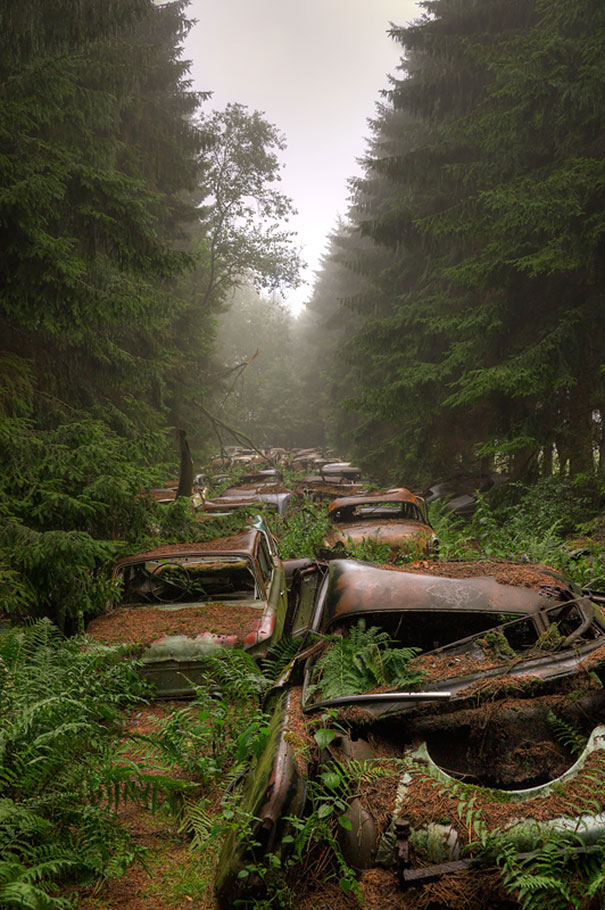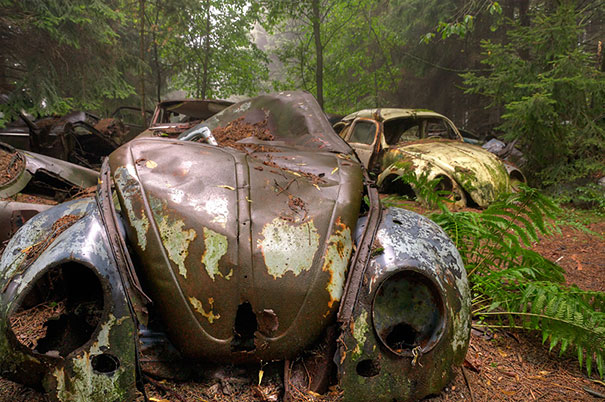The scene looked like something out of an apocalyptic movie. In Belgium, there were rows of dented and rusted cars with forest greenery growing around them. It’s like a cemetery for old cars, which was why the place was called the Chatillon Car Graveyard. One urban legend said these cars were owned by US soldiers during World War II. They couldn’t pay for the expensive shipping to return their cars back to the States, so they hid them in this forest, planning to return for them but they never did. However, locals claim the site was just a dumping ground for old cars after the second world war. But the real story is a little more complex than that. [1]
How Did the Forest Car Collection Begin?
Keep in mind, in 2010, the traffic jam was cleared to help the forest environment. Still, many visitors still go out to Chatillon, only to learn from the residents that the cars are gone.
In a post on Digital Trends, Ronan Glon explains how he went to the now-empty site himself. [2] The story about the US soldiers leaving their cars after the war doesn’t work when you realize that most of the cars in the pictures were built after World War II. So they couldn’t have been abandoned by deployed American soldiers in the mid-1940s.

Aside from the once car graveyard in the forest, Chatillon doesn’t have many defining attributes as a small village in the Belgian countryside. However, the forest still stands, along with the immense clearing where the cars once stood. But instead of greenery growing through a traffic jam, there are scattered parts, covered in rust. Brake drums, to tires, to steering wheels. There is one car left, a 1960s first-generation Ford Cortina without the front and back coverings. That alone disproves the World War II urban legend.

Read: Researchers Capture Rare Footage of Fish That Sees Through its Own Head
The Traffic Jam Begins
But with the cars gone, the most notable part of Chatillon is an old, abandoned hangar. Moreover, the hangar was once a repair shop whose owner used the clearing in the forest to store old cars he took apart for parts. Additionally, the shop specialized in working on American cars after it opened in the early 1950s. This was especially handy for the many Canadians who moved to the area after the second world war to maintain a nearby Air Force base created by North Atlantic Treaty Organization (NATO). Simply put, NATO was an alliance between twelve countries with the goal to prevent a third world war.

As soldiers and their families came to the area in 1955, many settled in Virton, which is fairly close to Chatillon, and bought the American cars they were used to. This brought much business for the car shop owner who had learned English to better speak with his clientele. However, it was hard to get enough of specific parts. So when American cars became too old or mangled to repair, the owner kept them in the clearing in the forest. Thus, the traffic jam began.
But in 1965, French President Charles de Gaulle resigned France from NATO and requested the forces to exit the country. So by 1967, all of the Canadians left Virton. And the shop owner shifted his focus to European cars. And he continued to collect cars, in the forest, in an empty plot of land about 500 yards away, and next to a garage on the opposite side of the village. At one point, there were almost 400 cars stored up.

Read: The mystery of the Bermuda Triangle may finally be solved
The End of the Car Collection
After the owner passed away, the cars remained. But then a Flemish TV station filmed a documentary about the strange traffic jam. The shop owner’s family didn’t know about the documentary until after it aired. They got no compensation, only throngs of curious visitors coming to the tiny village to see the cars. The private collection became a tourist attraction. They weren’t an annoyance at first, but then people began to steal parts, party by the cars, and leave litter everywhere. The house next to the shop was broken into several times as well.
Additionally, the owner’s son was the mayor’s assistant specializing in environmental issues. So his opponents used the junkyard of over 200 cars to question his credibility. Plus, the clearing was classified as farmland, so the collection was technically illegal. His opponents took the zoning issue to court and won. The son decided to get rid of the cars once and for all. It took about two weeks to complete the process.
So don’t go looking for a traffic jam in a Belgium forest. But it deserves a special place in the history books for one of the strangest tourist attractions with a rather interesting backstory.
Keep Reading: Abandoned Airplane Takes Off Again As Luxury RV
Sources
- “This Traffic Jam Was Stuck In Belgian Forest For 70 Years.” Bored Panda. Julija Nėjė.
- “What really happened to Belgium’s infamous car graveyard?” Digital Trends. Ronan Glon.

